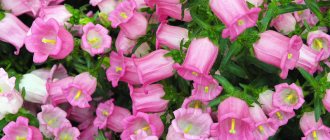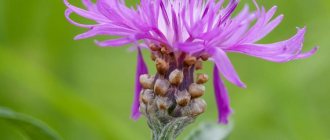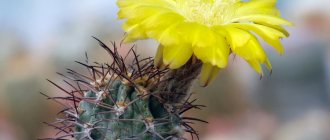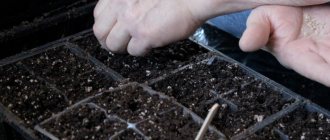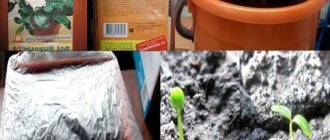Author: Elena N. https://floristics.info/ru/index.php?option=com_contact&view=contact&id=19 Category: Garden plants Published: February 09, 2019Last edits: January 20, 2021
- When to plant
- Growing conditions
- How and when to collect seeds
- Clarkia graceful, or marigold (Clarkia unguiculata = Clarkia elegans)
Clarkia is a charming flowering annual, an elegant and beautiful plant, closely related to godetia. Clarkia seeds germinate well, seedlings grow very quickly, and flowering lasts about three months. Clarkia is represented by many species and varieties of different colors, including those with double flowers, which are located on the peduncles so densely that the leaves are almost invisible because of them.
Our article contains information about:
- what varieties of clarkia are the most popular;
- how to sow clarkia seedlings;
- when and how to transplant seedlings into a flower garden;
- how to care for the plant during the season;
- how to collect clarkia seeds.
Planting and caring for clarkia
- Planting: sowing seeds in the ground - in April or early May, you can, but sow them before winter; sowing seeds for seedlings - in March, transplanting seedlings into the ground - in the second or third ten days of May.
- Lighting: bright sunlight.
- Soil: loose, light, dry, fertile, slightly acidic soil. Oily soil is not suitable for the plant.
- Watering: only during drought - twice a week.
- Feeding: during the periods of budding and flowering, once every two weeks with complex mineral fertilizer.
- Reproduction: seed.
- Pests: mealybugs, garden flea beetles.
- Diseases: rust.
Read more about growing clarkia below.
flowers (lat. Clarkia) are a genus of annual herbs of the fireweed family, close to Godetia, which some botanists combine with Clarkia into one genus. The plant is named after the captain named William Clark who brought it from California to Europe in the 19th century. In nature, the clarkia flower grows in the west of North America and Chile and has more than 30 species, of which only three are of interest to gardeners.
Planting by seedlings
Gypsophila perennial: creeping, graceful
Seed material can be purchased at the store or prepared in the fall if a clarkia flower is already growing in the flower garden. The range of purchased seeds is very wide; specimens of different sizes and interesting colors are presented, as well as mixtures.
Important! Such seeds do not need to be processed; you can start sowing immediately.
Seedling
When harvesting seeds yourself, remove the ripe capsule (its brown color indicates ripeness) and remove the small seeds. They are treated with a solution of potassium permanganate.
When grown from seeds, clarkia is planted as seedlings when they want to get early flowering (early June). Step-by-step description of the process:
- In March, the seeds must be planted in a shallow container with soil, moistened and covered with glass or a bag to create an optimal microclimate.
- Seeded containers are placed in well-lit areas.
- Water generously throughout the week. After a few days, friendly shoots appear.
Important! Do not bury the seeds too deeply, as they are very small. It is enough to lightly sprinkle them with soil.
At first, Clarkia seedlings look like tiny sprouts with cotyledon leaves. When 2 full-fledged leaves appear, a pick is made - the seedlings are planted in separate containers. These can be plastic cups or, preferably, peat pots. Until May, when it is time to plant in the ground, the seedlings are kept in a bright place without direct sunlight. Young plants require regular watering.
Botanical description
So, the clarkia plant is an annual herbaceous crop, reaching a height of 30 to 90 cm. The stems of clarkia are branched, erect, usually pubescent with short villi. Elongated oval sessile leaves of bright green or bluish color are arranged alternately. Simple or double axillary flowers of regular shape with a diameter of up to 3.5 cm, painted in different colors, usually collected in spike-shaped or racemose apical inflorescences, but occasionally a single arrangement of flowers is found. The calyx of the flower is tubular, the corolla consists of four whole or three-lobed flowers, which taper at the base into a marigold. The fruit of clarkia is an elongated polysperm.
- Lotus settled in the country house
Features of Clarkia
Clarkia is a herbaceous annual whose height can vary from 0.3 to 0.9 meters. On the surface of erect branched shoots there is often pubescence consisting of short fibers. Sessile, alternately arranged leaf plates have an oval-elongated shape and a light gray or rich green color. Axillary flowers can be double or single; they have a regular shape and reach 35 mm in diameter. And they can be painted in different color shades. As a rule, they are part of the apical inflorescences, which have a racemose or spike-shaped shape, but sometimes single flowers are also found. The flower has a tubular calyx; the corolla includes 4 three-lobed or solid petals, tapering at the base into a marigold. The fruit is an elongated polysperm.
Clarkia
Growing clarkia from seeds
How to sow seeds
Clarkia flowers are grown by seed - seedlings or non-seedlings. With the seedless method, clarkia seeds are sown directly into the ground. This can be done in April or early May, as well as in late autumn, before winter. Before sowing clarkia, add 1 kg of peat per m² and a tablespoon of potassium sulfate with superphosphate to the area to be dug, and a tablespoon of each for the same area. You need to dig up the area with fertilizers at least two weeks before sowing.
Small clarkia seeds are sown in nests of 4-5 pieces at a distance of 20-40 cm, but are not buried in the ground, but lightly pressed onto it and sprinkled with the thinnest layer of soil. Shoots may appear in as little as two weeks, and you will have to thin them out, but don’t get carried away—clarkia blooming in a dense bush looks more beautiful. When planted in autumn, the seedlings have time to germinate before the onset of winter and are preserved well under the snow, but even if the crops do not germinate, there is nothing to worry about. In the spring, when Clarkia sprouts, you only need to thin it out, like carrots.
Seedling care
Clarkia from seeds, grown by seedlings, at the very beginning of its life is reliably protected from temperature changes, frosts, cold spring rains and other seasonal and climatic troubles, which is why many flower lovers prefer to grow seedlings rather than sow flowers directly into the ground. Clarkia seeds are sown for seedlings in March, then it will bloom in early June.
Sow the seeds in slightly acidic soil, press them down with a board, sprinkle them with water, cover with glass and place in a bright, warm place out of direct sunlight. As soon as the shoots appear, the glass can be removed, but the container with the crops should remain in a dry, warm place with good ventilation until planting in open ground. Clarkia should be picked as early as possible - as soon as the seedlings have their first leaves.
Species of clarkii
Carnivorous plants - insectivorous flowers at home
Natural forms of clarkia are divided into more than 30 species. However, flower growers use three cultivated types, which have given rise to many varieties. In addition to the graceful (or marigold), in gardens you can find terry and pretty clarkia.
Terry variety
Terry has a profusely branching bush with dark green leaves. The flowers are quite large (5-6 cm), double. The color is varied. The Sakura variety is especially prized - Clarkia with a delicate peach color.
Note! You can grow Clarkia as a house plant by planting it in a flower pot. But you should remember that this is an annual plant, so you won’t be able to admire it for more than a year.
Pretty is a compact, graceful plant 20-40 cm high. The flowers are semi-double, white, pink and salmon. Petals are carved. Valued for its early flowering, the pretty clarkia blooms 2-3 weeks earlier than other species.
Clarkia Pretty
Planting clarkia in open ground
When to plant
Clarkia flowers are planted in open ground in May. If the soil on your site is not suitable for clarkia due to its pH value, there are several ways to acidify it: add one to one and a half kilograms of peat or 60 g of sulfur per square meter to the soil for digging, or spill the soil with a solution of oxalic or citric acid at the rate 1.5 tablespoons per 10 liters of water. If the soil is too acidic, it is limed before planting the clarkia, and if it is too oily, the area is dug up with sand. Well, don’t forget to add fertilizers, which have already been mentioned. You need to prepare the area for Clarkia at least two weeks before planting.
How to plant
Clarkia is planted in this way: seedlings are taken out of the container not one at a time, but in groups, together with a lump of earth, and also planted in holes located at a distance of 20 to 40 cm from each other. Near each hole you need to stick a stick or a rod, which will serve as a support for the thin stems of the clarkia when the bushes grow. Plant different varieties of plants at a distance from each other, because they can cross-pollinate with each other. After planting, the plants are watered and lightly pinched to stimulate tillering.
- How to plant and care for heuchera
Description
In its natural environment, clarkia is found in the northern part of the American continent, as well as in Chile. The crop is an annual plant, which, depending on the variety, is medium or tall - its length varies from 35 to 90 cm. The stems are erect, highly branched, abundantly pubescent with short but dense fibers. The leaf blades are bright green in color and may have a bluish coating. The shape is elongated, oval, the leaves are arranged alternately. The flowers are axillary, can be simple or double, the diameter reaches 3 cm, the color can be very diverse. They are usually collected in spicate or racemose inflorescences; a single arrangement is rare. The petals can be whole or three-lobed, the calyx is usually tubular. The fruit is an elongated polyspermous capsule.
Clarkia care
Growing conditions
Growing clarkia and caring for it will not require any special knowledge or effort from you. The plant only needs to be watered twice a week during dry periods, and the rest of the time, rain moisture will suffice for Clarkia. For irrigation, you need enough water so that it is quickly absorbed and does not stand in a puddle around the plant.
During the periods of budding and flowering, Clarkia is fed with complex mineral fertilizers once every two weeks. Kemira or Rainbow are suitable for this purpose; Clarkia is not fertilized with organic matter. Remove faded flowers and seed pods so that the plant spends its energy only on the formation of new buds. That's all there is to caring for Clarkia.
Pests and diseases
Of the insect pests, clarkia is affected by the mealybug, traces of whose vital activity look like a cotton wool-like waxy coating on the ground parts of plants. Mealybugs are combated by spraying with Aktara, Confidor or Fitoverm.
If the soil in the area with clarkia is loamy, this may cause a fungal disease, manifested by rusty-yellow spots with a brown border on the leaves. To destroy the fungus, the plant is sprayed with fungicides - Bordeaux mixture or oxychome, for example. In general, Clarkia is a very resistant plant to pests and diseases, and if you properly prepare the soil for it, neither it nor you will have problems with it.
Features of care
Growing clarkia is relatively easy, and even a beginner can handle this task with ease. Watering should only be done when there is a long dry hot period. In this case, watering only needs to be done a couple of times every 7 days. At other times, rainwater will be enough for such flowers. When watering, you should take into account that the liquid should be quickly absorbed into the soil, and not stand for a long time around the bush. Fertilizing should be done only during the period of bud formation and flowering, and it is recommended to use complex mineral fertilizer for this. The frequency of fertilizing is once every half month. It is recommended to use Rainbow or Kemira as fertilizers, but organic matter cannot be added to the soil. In order for the flowering to be long and lush, fading flowers must be removed in a timely manner.
Diseases and pests
Among the harmful insects, the mealybug can settle on clarkia. You can tell that a bush is infected with this pest by the presence of a waxy, cotton-like coating that can be found on the above-ground part of the plant. To destroy this insect, it is recommended to treat it with confidor, actara or fitoverm.
If the soil in the area where Clarkia grows is loamy, this may contribute to the development of a fungal disease. The fact that the bush is infected can be understood by the specks of a rusty-yellowish color with a brown border, which are located on the leaf blades. To get rid of this disease, you should treat the bush with a fungicidal agent (oxych or Bordeaux mixture). If you plant this flower in suitable soil and care for it properly, it will have very high resistance to both diseases and harmful insects.
Clarkia after flowering
How and when to collect seeds
Actually, Clarkia reproduces well by self-sowing; you just need to carefully thin it out in the spring, when the bristles of Clarkia seedlings appear. But if you still decide to collect the seeds, then doing it couldn’t be easier: select several beautiful flowers during flowering and, when they begin to fade, tie them with gauze so that the seeds, when ripe, do not fall to the ground. The seeds ripen a month after the end of flowering, when the capsule turns brown. Cut off the seed pod, sprinkle it on newspaper, dry it and sow it before winter or store it in a paper bag until spring.
Clarkia in winter
After the clarkia has finished blooming, it can be cut back to the ground, and when it comes time to dig up the area, remove the remains of the clarkia and destroy them. It is best to burn them to prevent the development of pathogenic bacteria and fungi in them, which can infect the soil or healthy plants.
Pest and disease control
Clarkia has good disease resistance. Very rarely, due to prolonged waterlogging, brown spots or a whitish coating appear on the shoots. This is a fungus, so you need to destroy diseased plants and treat the area around with fungicides.
Clarkia also has few pests, and most often it is a simple garden flea or mealybug. When the colony grows, they inhibit the growth and development of young plants. But it’s easy to get rid of parasites with the help of special medications. Otherwise, clarkia attracts only beneficial insects.
Photo: rastushka.ru
Calendula (50 photos): types, planting and care in open ground
Types and varieties
As already mentioned, only three types of clarkia are grown in garden culture: clarkia marigold, or clarkia graceful; pretty clarkia, or pubescent clarkia; Clarkia Brevery.
- Spiraea japonica
Clarkia graceful, or marigold (Clarkia unguiculata = Clarkia elegans)
The Clarkia graceful flower grows wild in California. It is a branched, dense annual up to a meter high. Its stems are strong, thin, woody in the lower part, the leaves are oval, bluish-green with red veins, unevenly sparsely toothed along the edges. Regular flowers up to 4 cm in diameter, simple or double, white, red, purple, pink or blue, are located one at a time in the leaf axils. Small seeds remain viable for up to 4 years. Blooms profusely from July to September. Growing Clarkia elegans is very common in our climate. Popular varieties:
- Albatross - terry clarkia white, the height of the branched bush is about 75 cm;
- Purpurkenig - a double variety of carmine color, flowers with a diameter of 3.5-4 cm, bush height 80-90 cm;
- Salmon perfection - double, salmon-pink flowers up to 3.5 cm in diameter, loose bush up to 90 cm high.
Clarkia pulchella
The plant is dwarf. Its stems are branched, erect, up to 40 cm tall. The leaves are green, long, narrow, entire, pointed towards the apex and tapered towards the petiole. The flowers are simple or double, solitary or collected in several pieces in the axils of the leaves on the tops of the shoots. The shape of the petals, divided into three widely spaced lobes, is original, which is why the Americans nicknamed this species “moose horns.” It blooms two weeks earlier than the graceful clarkia.
Clarkia breweri
For some time now, the species Clarkia Breveri has been gaining popularity - a cold-resistant annual up to 50 cm high. The butterfly-like flowers, up to 3 cm in diameter, forming loose inflorescences, have a strong and pleasant aroma. Varieties:
- Pink Ribbons is a variety with pink flowers, the petals of which resemble ribbons, the height of the bush is only 30 cm, the stems are branched, the flowering is abundant.
All the other Clarkia species you've heard or read about are actually members of the genus Godetia.
Popular varieties
What a violet looks like - description of the plant
The color of clarkia allows landscape designers to experiment with color combinations. Purple, deep pink, salmon and coral specimens allow you to create a pink flower garden in different shades. Monochrome compositions are no less impressive. A flowerbed consisting exclusively of white flowers invariably attracts attention.
Common varieties of Clarkia gracefu:
- Albatross with pure white petals looks especially impressive in the evening or early morning;
- Purpurkenig is a variety with double flowers of rich color. Purple flowers contrast with green foliage, adding expression to the floral arrangement;
- Salmon perfection has pink double flowers. The bush is large, 80-90 cm in height;
- Sun. This variety has double, single, salmon-colored flowers. Plant height up to 70 cm;
- Orange is a low half-meter plant. It has double flowers of an impressive orange color.
Clarkia – photo
Clarkia will become the pearl of any flower garden, filling the garden with color and creating a fabulously romantic atmosphere. Just look!
Photo: jardinage.ooreka.fr
Photo: commons.wikimedia.org Photo: plantarium.ru Photo: ptk-granit.ru
Photo: theflowers.su Photo: rastenievod.com Photo: packagile.ru
Photo: etsy.com
Photo: etsy.com
Photo: ind.thehouseofchronic.com Photo: 2sotki.ru Photo: etovsecvetochki.vsite.biz
Photo: rhonestreetgardens.com
Photo: dizajninterer.ru
Photo: tmousecmouse.blogspot.com
Photo: krispgarden.blogspot.com
Photo: raduga174.ru
Photo: lisky.org.ua
Photo: dev.ogorodniki.com Photo: 2sotki.ru
Photo: lisky.org.ua
Photo: pugachevsky-site.ru
Photo: zen.yandex.ru
Photo: 56440696406159.moi-6-sotok.rf
Did you like the post? Subscribe to our channel in Yandex.Zen, it really helps us in our development!
Possible infections and pests
Clarkia is highly resistant to various diseases and pests. Sometimes, when kept in too humid conditions, signs of fungal infections appear: gray bloom, spots on leaves and stems, darkening of areas on the stem. At the first signs of disease, the bush must be removed, and the soil under it and neighboring plantings treated with any fungicide or Bordeaux mixture (1%).
If the flower bed is located near vegetable beds, then the young tender shoots may be favored by the garden flea beetle. Treatment with Karbofos and Fufanon will help. When a mealybug appears (a cotton wool-like coating appears on the bush), the plantings are treated with Aktara, Fitoverm, and Confidor.
Beautiful bright clarkia bushes will decorate not only a garden plot or local area, but will also transform a balcony, loggia, terrace - the flower can be grown in portable boxes, in a flowerpot, in a flowerpot, or in a pot. Planting and care in this case are carried out in the same way as in open ground.
Clarkia and other plants
From clarkia and other garden flowers you can create an amazingly beautiful flower garden.
- Next to the bush you can plant phlox, lilies, white daisies and asters.
- Clarkia looks harmonious next to low red roses.
- If you cut the clarkia and keep it in water, it will stand for two weeks, slowly opening buds.
- Clarkia is often planted in groups to decorate ridges, for the purpose of landscaping balconies, and creating Moorish lawns.
Several types of clarkia can be planted in the garden at the same time. It is only important to make small distances between each type of plant. Since during pollination, future generations may lose their original species attractiveness by mixing with another variety.
Now you know how Clarkia is grown from seeds, as well as what types of plants there are and how to properly care for them. It is important to maintain proper care and then the bushes will decorate the garden throughout the warm period of the year.
Shrub varieties
Gardeners most often plant three types of flowers in their gardens: graceful clarkia, pretty and Brevery. Based on them, many different unique varieties have been bred.
Main types of shrubs:
- The graceful clarkia has a thin, branched, strong stem and grows up to 90 centimeters. The leaves are densely green with red veins and jagged edges. It blooms with single or double flowers in June and pleases with its flowering until the end of September;
- The pretty Clarkia grows to only 30 centimeters. Blooms with different double or non-double flowers. Blooms in mid-May and blooms until frost;
- terry clarkia has amazingly beautiful flowers. Plant height is 25 – 65 centimeters. The diameter of double flowers is 6 centimeters. They are strung on stems and in appearance resemble a spike-shaped plant;
- The Albatross variety has double white flowers, the bush is branched, its height can reach 75 centimeters;
- the Purpurkenig variety has double carmine flowers, 4 centimeters in diameter, the height of the bush reaches one meter;
- The Salmon Perfect variety has double, salmon-pink flowers with a diameter of 3.5 centimeters. The shrub is loose, no more than 90 centimeters high.
- The Diamond variety is also valued by gardeners. The tall bush has large bright pink double inflorescences;
- The Clarkia Sakura variety has double inflorescences of a white-pink hue. Its height is 120 centimeters, its appearance resembles a Japanese cherry;
- The bushes of the Sheftane variety have a lilac-lilac color and a height of 50 centimeters.
Growing terry clarkia
The terry type of clarkia is always planted only in open soil.
The height of the bushes is 90 centimeters. The flowers are unusually double. As soon as the first shoots and the first four leaves appear, plant the shoots at short distances between them. They need to be replanted together with small lumps of earth into holes prepared in advance. When the plant stems become strong, the bushes on top need to be pinched. Caring for the terry type of clarkia is also easy.
It is important to regularly water the bushes as needed, right to the roots and fluff up the top layer of soil. Feed with mineral fertilizers during budding. Terry clarkia blooms from July to the end of September. Pest protection is carried out in the same way as the protection of the graceful clarkia.
Description of the flower
The flower grows no more than 85-95 cm. The shoots with this growth are erect, very branched due to the formation of new stems from the lateral axils. Slight pubescence is often observed on the shoots. The edge has small fine fibers. The leaves are green, with a bluish tint. They are located alternately on the shoot. The shape of each leaf is a slightly elongated oval.
Flowers are formed from the axils of the leaves, which can be either simple or double. When opened, each flower is up to 3-4 cm in diameter. The petals have a very different color: from snow-white to burgundy shades. The inflorescence is formed mainly at the top of the shoot. The flower consists of a tubular calyx and four-lobed petals, of which there can be four or three on one flower.
If the clarkia is double, then there are many such petals. When flowering, the aroma spreads throughout the area, attracting insects for pollination. As a result of pollination, very small seeds are formed, located in a capsule.
After planting the seeds, the plant will bloom in two months. Typically flowering lasts one and a half to two months.
Growing
You can grow a flower by sowing seeds in open ground or sowing seeds for seedlings. Or it will grow itself by self-seeding.
If the seeds are sown directly into the soil, this should be done at the end of April or beginning of May. If desired, you can sow in late autumn, before autumn frosts. The soil must be fertilized before planting. To do this, add half a bucket of peat soil, and 15-20 grams of superphosphate and potassium sulfate to a plot of one meter square of land.
You can sow seeds in grooves, or several seeds in one hole. If you sow in ditches, do not sow very thickly, otherwise you will have to replant the seedlings. There is no need to cover with a layer of soil, just press down lightly and sprinkle with a thin layer of soil or sand. If seeds are sown in autumn, they are covered with a small layer of soil, but not more than 1.5-2 cm.
The seeds are small, and when they are heavily covered, over the winter they will end up deep inside the soil. And in the spring it will take a long time to germinate. If the seeds managed to sprout in the fall, it’s okay. They will remain under the snow until spring.
When there is no snow, but frost sets in, you need to cover them with dry leaves or spruce branches. Of course, when sown in the ground, some of the sprouts will die from snow or cold rain, temperature changes or strong winds. To play it safe, many gardeners plant Clarkia flowers through seedlings.
The seeds need to be sown in mid-March, then it will bloom around June. The soil should be slightly acidic. To do this, a mixture of peat, leaf soil and sand is watered with slightly acidic water. It can be made by adding citric acid crystals to water.
The small seeds laid out do not need to be covered with soil. They are sprayed with warm water on top and covered with glass or film. The container must be placed in a lighted place, with a temperature of 20 degrees. Every day you need to raise the glass and ventilate it. If necessary, the soil is sprayed with water at room temperature.
When the first seedlings appear, the cover is removed. You need to pick out the sprouts after 4-5 leaves appear. The soil for containers can be taken the same as when sowing seeds. Several pieces are planted in one container.
Planting in open ground
In mid-May, seedlings can be planted in prepared holes.
The soil should be prepared ten days before planting.
The soil for planting needs to be slightly acidic. And fertile. If there is not enough acid, you can dilute the soil with peat or acidic water. It is prepared using citric acid. In the case of highly acidic soil, it is mixed with sand. Fertilizers are applied both mineral and organic.
Information: Clarkia is planted in one hole, several at a time. Without separating the sprouts or shaking the soil, remove the contents from the container and place it in the hole. Between the pits a distance of 25-30 cm is maintained.
When plants grow, they need support, because it is difficult for thin shoots to support foliage with a large number of flowers. You can stick a rod or stick near the hole when planting or later, as the plants grow. After planting, the bushes are watered. For fluffiness, you can pinch the top. Then shoots will grow from the lateral sinuses.
Reproduction
Clarkia reproduces by seeds. You can first grow seedlings or immediately sow them directly into open ground. Pay attention to the expiration dates of the seeds; in Clarkia they remain viable for a maximum of 4 years.
The seedling method allows for earlier flowering and eliminates freezing of seedlings. This method is most suitable for northern regions. Clarkia is sowed for seedlings in March. This process is the same as for most other plants. Seeds are sown in special soil for seedlings without deepening them, just pressing them slightly to the ground.
It will be useful to read:
Flowers that need to be sown in March for seedlings The end of February and the whole of March is the peak of flower growers’ preparation for the planting season. This period is the most…
Then the crops are watered, covered using transparent film or glass, and placed in a bright place for germination. Shoots should appear in one and a half to two weeks. Clarkia can only be replanted at a very early age, so when the first true leaves appear, it needs to be planted in cups, preferably peat ones, to prevent injury to the roots when planting them in a flowerbed. You can plant grown seedlings in flower beds with the onset of stable warmth: in May for the southern regions, in June for the more northern regions. If the seedlings were planted in plastic containers, then they need to be transferred along with a lump of earth.
The easiest way is to sow seeds directly into open ground. When can you plant clarkia? Since this plant is relatively cold-resistant and gives good self-sowing, this can be done in the spring in April or in the fall with the onset of persistent cold weather (so that the seeds do not immediately begin to germinate).
Clarkia graceosa seeds
We begin growing clarkia from seeds by preparing the site and soil. This heat-loving plant requires sunny places for planting (can grow in openwork partial shade). The soil should be loose, loamy, well-drained, moderately fertile, with a slightly acidic reaction. If the soil is very oily (excessively fertile and wet), then the plant may die.
Clarkia seeds are very small, so, if possible, they are evenly distributed in rows or patches, not covered, but lightly pressed into the ground using a board (“trampled down”). Water by sprinkling so that the seeds are not washed out.
Young shoots are thinned out. The optimal interval between plants is 20-25 cm. Grown seedlings are planted at the same distance.
It is very important to pinch young shoots at a height of about 12 cm. This stimulates the plant to intensively branch and also ensures a stable bush shape.
Sown directly into open ground, clarkia grows stronger, with thick stems, and resistant to unfavorable conditions.
Clarkia value
The graceful clarkia has delicate beauty and elegance. It is also appreciated for the following advantages:
- the clarkia flower blooms within a couple of months after sowing and pleases with its decorative effect before the onset of frost;
- The plant is sown in open ground. If you sow the seeds in the fall, the bush will grow strong and hardy;
- seeds have increased germination capacity and can germinate quickly;
- during the season, full-fledged high-quality seeds ripen;
- the plant can self-sow, retaining its original varietal characteristics.
The most decorative and valuable plant is considered to be the marigold or graceful clarkia, as it can bloom in white, soft pink or lilac shades.
It is recommended to plant Clarkia in areas with intense light in open areas. Flowers are grown on dry, fertile soils.
Transferring seedlings to open ground
When growing clarkia from purchased seedlings, this operation should be scheduled in your gardener’s calendar for the first consistently warm week of spring or summer. It is advisable to carefully prepare the flowerbed for this purpose another half month in advance.
The farmer’s task is standard digging and subsequent fertilization
- potassium sulfate;
- granulated superphosphate;
- peat substrate.
Soil with an acidic reaction should be sprinkled with dolomite flour. Alkaline soil is watered with a solution of citric acid.
When and how to collect clarkia seeds
In place of the withered flower, an elongated seed pod is formed with many small seeds, which will take a month to ripen. During this time, the color of the testis will change from green to brown.
After complete ripening, the testis spontaneously opens and self-seeding occurs. Next year, in the spring, a thick carpet of clarkia seedlings will appear in this place. It can be thinned out and left for further cultivation or transplanted to a new location.
If you decide to collect seeds, then the plants you like are noted at the flowering stage. A bright ribbon on the stem will prevent you from losing the desired bush. When the flower withers, it is wrapped in gauze or very thin cloth - this will prevent self-seeding. After a month, the seed capsule will ripen and is cut off. Dry if necessary. The seeds are poured onto a sheet of paper and packaged, accompanied by an inscription indicating the variety and harvest date.
The collected seeds are used for winter sowing or left until spring.
On a note. Clarkia seeds remain viable for up to 4 years.
Combination with other plants (Clarkia in landscape design)
Thanks to its unpretentiousness and abundant flowering, Clarkia deserves a place of honor in landscape design.
Scope of application:
- in flower beds, along fences, alleys, fences;
- in pots on balconies, window sills, on walls (low-growing varieties);
- in bouquets with other flowers (tall varieties).
In addition, its flowers have a beautiful aroma and are a good peduncle. It goes well with other low plants:
- lilies;
- phlox;
- asters;
- white daisies;
- Red roses.
Clarkia is a very popular crop for growing in open ground. Caring for it does not require much effort. The flower reproduces well both by seedlings and without seedlings. It can grow almost anywhere, even in partial shade and drafts. The main thing is to provide it with suitable soil and regulate the moisture level.
More useful information about growing clarkia from sowing to collecting seeds can be found in the video:
Growing seedlings
The soil's degree of fertility can also vary.
For some, dry and rich in humus is preferred, for others - moderately fertile with an alkaline reaction. Saxifraga obtufolia prefers acidic soil; for long-leaved saxifrage, the area needs to be limed, and for paniculata, it will grow well in both neutral, calcium-rich soil and slightly acidic soil. Saxifraga with pink flowers
It is important to ensure that the soil around the plant is always moderately moist, but without stagnant water. Spraying (sprinkling) plants is also useful, as they like high air humidity
It is enough to feed saxifrage twice a season with complex mineral fertilizers.
You should know that these plants are very sensitive to various plant residues getting on their pads. For example, if tree leaves fall on saxifrage, their damping off will begin.
Delicate saxifrage
Vegetative propagation
Saxifragas easily reproduce by dividing the bush in August. The bush is dug up and broken into several sections, which are planted in new places.
In June-July, some types of saxifrage, which form long side shoots, can be propagated by cuttings. Branches up to 10 cm long are cut and planted in loose peat-sandy moist soil and shaded from above. Over the summer, the cuttings take root and form small independent rosettes, which are covered with a layer of leaves for the winter.
Planting saxifrage
You can transplant the plants into pots and put them indoors for the winter. Next year they are planted in the garden, and they will already bloom.
Saxifragas themselves reproduce by rooting cuttings. Their creeping shoots, when in contact with the ground, give roots and form new plants.
You can grow a flower by making seedlings. Growing saxifrage from seeds at home of the “Purple Mantle” variety is especially advisable in central Russia, since this will allow the plant to develop at an earlier date. Sowing of seedlings is carried out in the middle or end of March. First, the seeds must undergo stratification, that is, cold treatment. Thanks to the procedure, the percentage of seed germination increases. The container for sowing must be prepared not too deep and filled with 3–4 cm of sand and peat soil. Then the substrate is moistened, the seeds are sown, pressing them tightly. Cover the container with film and put it in the refrigerator for 3 weeks.
After the expiration date, the container is removed from the refrigerator, placed near a bright window, and it becomes a small greenhouse, which must be ventilated periodically by lifting the film. The ambient temperature must be at least 20°C, and the soil must be moistened from a sprayer. The film is finally removed after the shoots appear. Sprouts appear after 10 days. After the formation of 2 leaves, the seedlings are planted in separate cups.
It is necessary to plant saxifrage seedlings in a permanent place together with a lump of earth, carefully removing it from the glass. The distance between seedling bushes during planting should be approximately 10 cm.
